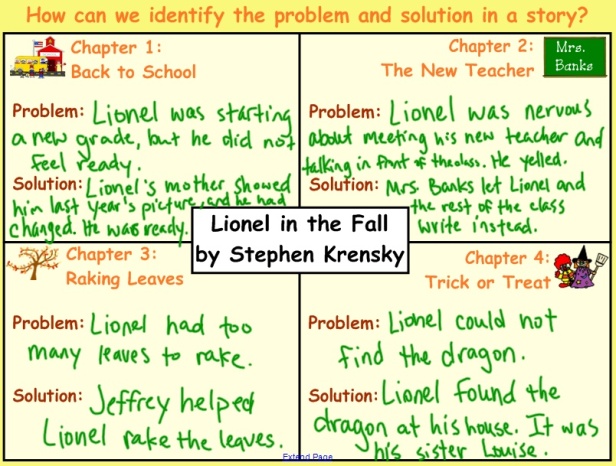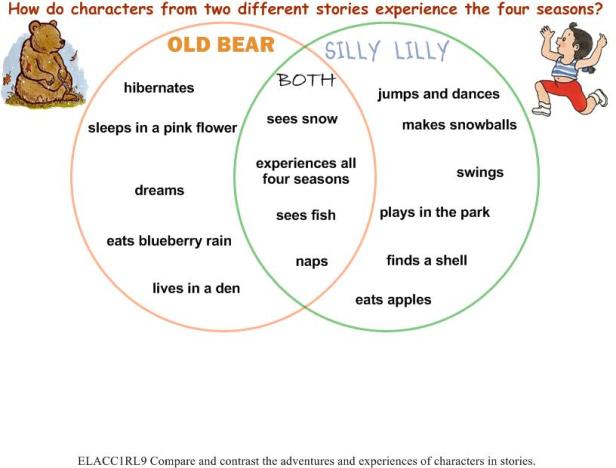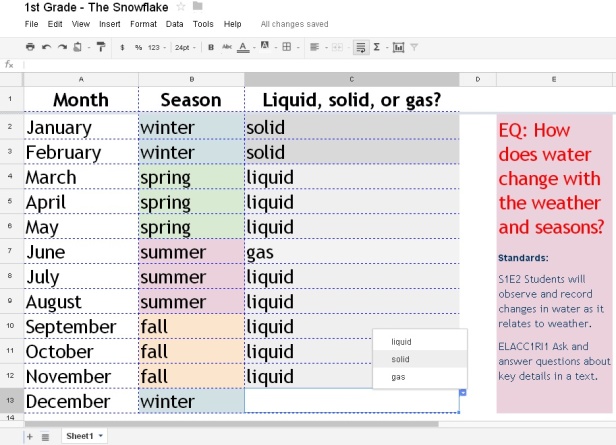Our 1st grade students have been hard at work in science lately! They have been learning all about the four seasons, changes in weather, and the water cycle.
To reinforce this learning, we have been reading books about these topics in the library and exploring them in a variety of ways.
Stories about the four seasons are some of my favorite books to read with kids because they can always make so many connections to what the characters do in each season.
Our seasonal stories this year included Lionel in the Fall by Stephen Krensky, Frog and Toad All Year by Arnold Lobel, Old Bear by Kevin Henkes, and Silly Lilly and the Four Seasons by Agnès Rosenstiehl, and for all of these stories, we focused on literary elements including character, events, problem, and solution.
Lionel in the Fall was a perfect read-aloud for discussing problems and solutions:

This beginning chapter book has four chapters about things Lionel does in the fall, and in each chapter Lionel faces a different problem. We kept track of Lionel’s problems and how they were solved using this graphic organizer on the SMARTBoard:

Besides identifying problems and solutions in the story, 1st grade made tons of connections with Lionel’s character.
Just like Lionel, many of them had experienced jitters on the first day of school, felt nervous about speaking in front of a group, faced chores that seemed impossible, and enjoyed an evening trick-or-treating on Halloween. I think the Halloween chapter was almost everyone’s favorite!
The book Frog and Toad All Year worked wonderfully for comparing and contrasting characters:

In this funny beginning chapter book, good friends Frog and Toad experience all four seasons together, beginning with a sledding adventure in the wintertime and wrapping up with a cozy Christmas eve.
I love the structure of this book because it shows so clearly how the seasons change in a cycle!
As we read the book, we paid attention to how the characters of Frog and Toad were similar and how they were different. We especially focused on what the characters said, what they did, and how they felt during the story.
After we finished reading this book, we closed the lesson with a sorting game on the SMARTBoard:

Once we understood how to compare and contrast two characters in the same story, it was time for us to apply that skill two characters in two different stories.
Since 1st grade begins each school year with a Kevin Henkes author study, I was excited to read Old Bear with the kids–and they were thrilled to share with me all the other great Kevin Henkes books they’ve been reading lately!

Like Frog and Toad, Old Bear’s story takes him through all four seasons–in this case, via the vivid and beautifully illustrated dreams Old Bear has during hibernation.
Another character who experiences all four seasons is Silly Lilly:

This Toon Book is one of the brand new graphic stories in the library from my last book order, and let me tell you–it was a big hit! The kids loved the comic-style format and really identified with the character of Lilly.
After we read Old Bear and Silly Lilly and the Four Seasons (both of which are quite short), we tried our hands at a different kind of graphic organizer–a Venn diagram–to compare and contrast the characters:

The students had been using Venn diagrams in their classrooms as well, so this activity was perfect for them to show their understanding not only of the characters in the story but also of how this graphic organizer works.
The most challenging activity for us during this unit in the library involved Neil Waldman’s book The Snowflake: A Water Cycle Story:

Rather than reviewing literary concepts that students had already learned, this lesson introduced a science concept that students had not yet begun learning in their classrooms–the water cycle.
So, to introduce the story, we discussed how water changes when it gets colder or hotter and what words we can use to describe these changes.
Students were already familiar with the concepts of melting and freezing, and a few already knew the words evaporation and precipitation.
We talked about these words, then focused our discussion in to the three states of matter: solid, liquid, and gas.
The way the story is told, each page is a different month of the year. As we read, we discussed what season we were in during each month, then talked about which state of matter–solid, liquid, or gas–our snowflake had adopted on that page.
To help students record their observations, I created a Google spreadsheet with data validation so that students could come to the board and select the correct season and state of matter from a dropdown menu:

I combined the dropdown valudation with conditional formatting to make the cells change colors based on student responses.
The differently colored cells made it easy for kids to see that each season was three months long, and students also observed that most of the time, water’s natural state is liquid–it only changed to a solid or a gas during extreme heat and cold.
My 1st grade kiddos really impressed me with what they already knew about this topic, and this lesson ended up being a great preview for their study of the water cycle in their classroom the following week.
It has been so much fun learning about weather, seasons, and the water cycle with 1st grade this fall, and my brain is already swimming with ideas for how to make this unit even more engaging and meaningful for students next year. 🙂
